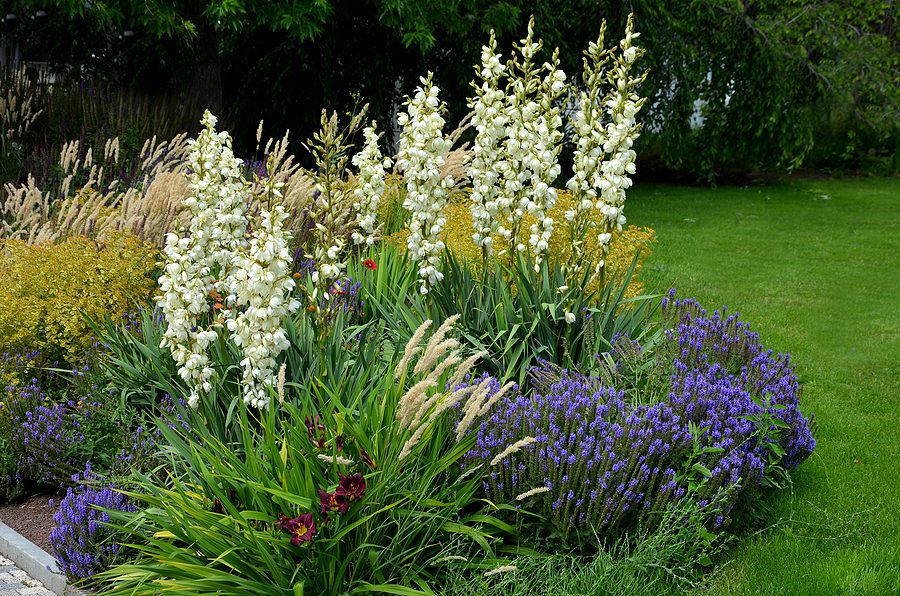Albuquerque Gardening with Perennials – Here’s How

The key to a lifetime of happy gardening may be as simple as planting easy-to-grow plants like perennials. My first time growing them, I was ten years old. Seeing those green shoots poking out from under the snow in late spring was truly something amazing!
Living somewhere cold with harsh winters like ours (USDA plant hardiness zone 5), it’s difficult to believe that anything could survive such an inhospitable climate. However, a combination of both sunny days and freezing temperatures produces a perfect package for your favorite blooms.
What a beautiful sight to see in early May, when my golden Achillea (yarrow) and white Alaskan Shasta daisies are already growing strong. It’s such an amazing feeling knowing these plants will be here year after year without any help from me!
So, let’s take a more in-depth look at gardening with perennials.
Perennial Garden Plants
The best way to get started with your perennial garden design is by looking around you. If there are neighbors that enjoy gardening, ask them which plants they have grown successfully and why those specific selections were made for their property.
Keep an eye on what sorts of flowers come back year after year without much maintenance – these may be perfect candidates in need of only a little TLC themselves each season.
Beware the predacious power of certain plants, especially in hot or humid climates. Peppermint and spearmint are notorious for overrunning your garden if you don’t keep them cropped. These two will quadruple in size year after year before demanding constant attention or else becoming impossible to remove completely.
There are many gardening books that can help you find the perfect plants for your garden. If it’s hard to decide which perennials would be best, try looking at local author recommendations in climate-specific guides or simply following zones according to their descriptions on how much sun and soil types they like. For example, a happy little pink flower called dianthus enjoys full sun and well-drained dry to moist soil – found in zones 3 to 8.
Soil for Perennial Flower Gardens
Your yard is your own personal garden, and everyone has its own special qualities. My neighbor across the street from me lives in light sandy soil full of organic matter which makes for a very fertile ground.
However, some locations have sticky dense clay that can sometimes lack nutrients due to – for example – being surrounded by evergreens which makes things difficult to grow.
It’s easy to determine what type of soil you have. Simply hold some in your hand and moisten it. It will either form a solid, sticky clay-like ball, a ball that feels sandy and easily falls apart, or something in between.
How to Design a Perennial Garden
You’ve decided which plants would be best for your garden, now it’s time to get serious about preparing the soil. A good first step in designing a perennial flower bed is performing a pH and nutrient test. This will show what nutrients are lacking or if there is too much of one thing already present. It will also show when you can start adding more goodies! Aim for a pH range of between 6 and 7 (slightly acidic to neutral).
Once you’ve made any adjustments needed to the soil, add 1 inch (2.5 cm) of compost to the top of the soil. Make sure the soil is not too dry or too wet and turn it over with a shovel, while avoiding trampling it after digging. The best time to do your soil preparation is in the fall before the next spring’s planting, however if this isn’t possible, you need to wait at least a day before planting.
If you want to get the most out of your perennials, make sure they are planted on a cloudy, cool day where possible. You should give them plenty space when growing since these plants will increase in size greatly over time! As for blossom removal – simply pinch off any spent flowers with your fingers. To keep soil at its optimum best, be sure rotted manure, compost or organic fertilizer is applied in Spring. Adding mulch will also ensure the soil remains moist and fertile.
If, over time, the plants have become overcrowded, there is a simple solution. Dig up the perennial clump, divide into 2 or 3 sections with a knife and replant them. It’s important during this process that you don’t let the roots dry out. You can then either expand your own flower bed, choose a different location to start another flower bed, or even give them away to friends and family. You can guarantee an increase in the number of friends you have if you’re giving away perennials!
Gardening with perennials is not only easy, but also fun! Each new bloom that appears year after year brings a source of enjoyment for you, and a satisfaction of a job well done!
